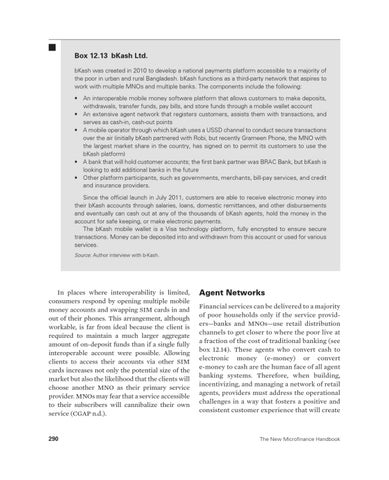Box 12.13 bKash Ltd. bKash was created in 2010 to develop a national payments platform accessible to a majority of the poor in urban and rural Bangladesh. bKash functions as a third-party network that aspires to work with multiple MNOs and multiple banks. The components include the following: • An interoperable mobile money software platform that allows customers to make deposits, withdrawals, transfer funds, pay bills, and store funds through a mobile wallet account • An extensive agent network that registers customers, assists them with transactions, and serves as cash-in, cash-out points • A mobile operator through which bKash uses a USSD channel to conduct secure transactions over the air (initially bKash partnered with Robi, but recently Grameen Phone, the MNO with the largest market share in the country, has signed on to permit its customers to use the bKash platform) • A bank that will hold customer accounts; the first bank partner was BRAC Bank, but bKash is looking to add additional banks in the future • Other platform participants, such as governments, merchants, bill-pay services, and credit and insurance providers. Since the official launch in July 2011, customers are able to receive electronic money into their bKash accounts through salaries, loans, domestic remittances, and other disbursements and eventually can cash out at any of the thousands of bKash agents, hold the money in the account for safe keeping, or make electronic payments. The bKash mobile wallet is a Visa technology platform, fully encrypted to ensure secure transactions. Money can be deposited into and withdrawn from this account or used for various services. Source: Author interview with b-Kash.
In places where interoperability is limited, consumers respond by opening multiple mobile money accounts and swapping SIM cards in and out of their phones. This arrangement, although workable, is far from ideal because the client is required to maintain a much larger aggregate amount of on-deposit funds than if a single fully interoperable account were possible. Allowing clients to access their accounts via other SIM cards increases not only the potential size of the market but also the likelihood that the clients will choose another MNO as their primary service provider. MNOs may fear that a service accessible to their subscribers will cannibalize their own service (CGAP n.d.).
290
Agent Networks Financial services can be delivered to a majority of poor households only if the service providers—banks and MNOs—use retail distribution channels to get closer to where the poor live at a fraction of the cost of traditional banking (see box 12.14). These agents who convert cash to electronic money (e-money) or convert e-money to cash are the human face of all agent banking systems. Therefore, when building, incentivizing, and managing a network of retail agents, providers must address the operational challenges in a way that fosters a positive and consistent customer experience that will create
The New Microfinance Handbook
